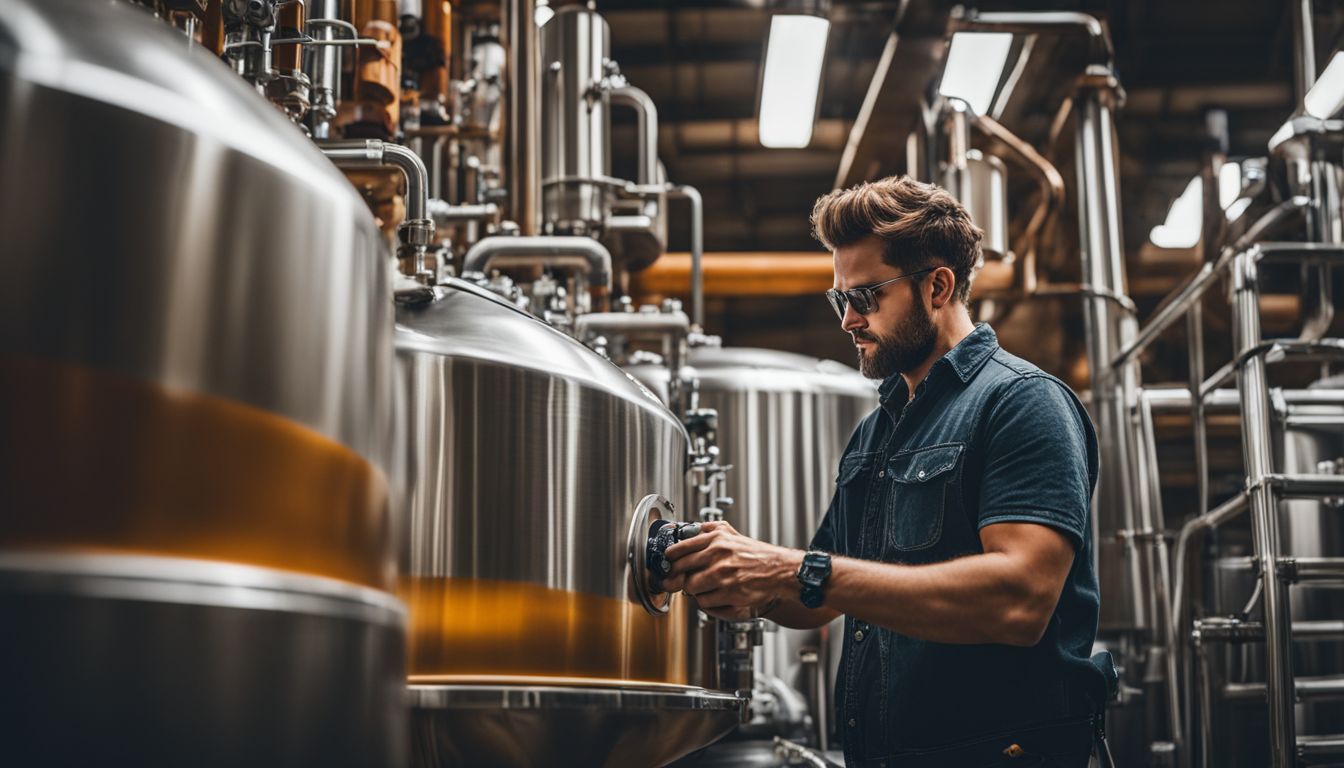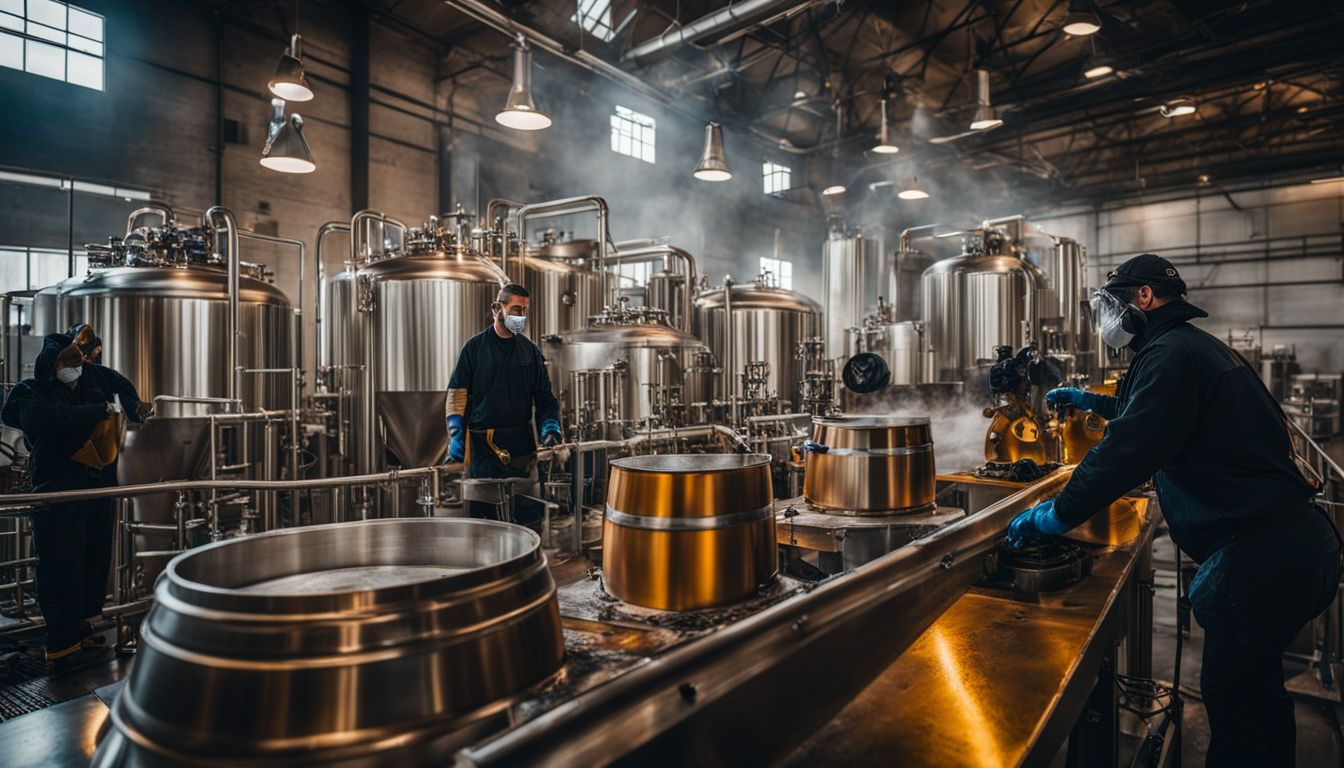The beer industry is much more than just a refreshing beverage option – it’s an economic powerhouse. Did you know that 1 in every 110 jobs worldwide is linked to the beer trade? This blog will unravel the intricate impact this fizzy amber liquid carries, from job creation to GDP contributions.
Ready to deep dive into a world where hops and barley shape economies? Let’s get started!
Key Takeaways
- The beer industry supports 1 in every 110 jobs worldwide, contributing to global employment.
- The global beer market was valued at $793.74 billion in 2022 and is projected to reach $1072.50 billion by 2030.
- Economic factors such as saturation levels, disposable income, taxes and regulations, and trade agreements affect the growth of the beer industry.
- The COVID – 19 pandemic led to a decrease in beer sales due to restrictions and financial hardships faced by consumers.
- Challenges for the industry include economic downturns, competition from other beverages, changing consumer preferences, regulatory restrictions, fluctuating raw material costs, environmental sustainability concerns, market saturation issues,distribution challenges,and demographic shifts.
- Political factors such as government regulations and taxation policies shape competitiveness in the beer trade.
- Socio – cultural factors like consumer preferences and drinking habits influence the demand for different types of beers.
- Technological advancements have improved production efficiency and quality control while making it easier for consumers to access a wide variety of beers through online platforms.
Economic Impact of the Beer Industry

The beer industry generates significant economic impact, creating jobs and contributing to the overall GDP of countries.
Beer industry statistics and facts

The beer industry has a significant global economic impact and contributes extensively to job creation and overall economic growth. Below is a snapshot of some key beer industry statistics and facts:
| Fact | Details |
|---|---|
| Job creation | 1 in every 110 jobs worldwide is related to the beer industry |
| Impact in the United States | The beer industry supports nearly 2.4 million jobs and contributes over $409 billion to the economy |
| Global market value | The global beer market was valued at $793.74 billion in 2022 and is projected to reach $1072.50 billion by 2030 |
| Value chain contribution of craft beer | Craft beer has been noted for its significant value chain economic contributions |
| Impact in Nigeria | The beer industry in Nigeria had an economic impact of $897.5 million |
| Economic factors | Factors affecting the beer industry include saturation at all levels, income levels influencing demand, and production and analysis |
| Sociocultural factors | Consumer preferences and cultural trends influence the beer industry |
| Environmental factors | Sustainability practices can impact the beer industry |
Understanding these facts helps appreciate the extensive influence of the beer industry on the global economy.
Global view of the beer industry

The beer industry has a huge impact on the global economy. In fact, it supports 1 in every 110 jobs worldwide. The global beer market was valued at $793.74 billion in 2022 and is projected to reach $1072.50 billion by 2030.
That’s a lot of money! Not only does the industry create jobs, but it also contributes to the GDP of many countries around the world. So next time you enjoy a cold beer, remember that you’re not just supporting your local brewery, but also contributing to the global economy!
Economic factors affecting the industry

The beer industry is influenced by various economic factors that impact its growth and stability. Here are some key factors to consider:
- Saturation levels: The industry’s growth can be affected by market saturation at different levels, such as regional or global, which can lead to increased competition and price pressure.
- Disposable income: Consumer demand for beer is often influenced by income levels. When people have more disposable income, they are more likely to spend on beer as a form of leisure and entertainment.
- Price elasticity: Beer is considered a normal good, meaning that demand tends to rise when incomes increase. However, it also means that consumers may be sensitive to price changes, impacting their buying decisions.
- Taxes and regulations: Government policies regarding taxes and regulations on the production and sale of beer can significantly impact the industry’s profitability and operations.
- Input costs: The cost of ingredients like barley, hops, and yeast can fluctuate due to factors like climate conditions or supply chain disruptions, affecting the overall cost of production for breweries.
- Trade agreements: International trade policies can shape the global beer market by influencing import/export tariffs, quotas, and restrictions on alcoholic beverages.
- Economic cycles: Economic downturns or recessions can affect consumer spending patterns, leading to shifts in beer consumption habits and preferences.
- Advertising and marketing strategies: Effective branding, marketing campaigns, and advertising budgets play a vital role in driving consumer demand for specific brands or types of beer.
- Innovation in brewing technology: Advancements in brewing technology and processes can lead to cost efficiencies for breweries while also introducing new flavors and varieties to cater to changing consumer preferences.
- Global economic outlook: Overall economic conditions worldwide can impact the industry’s performance as consumer confidence, GDP growth rates, and employment levels influence people’s purchasing power for discretionary items like beer.
COVID-19’s Impact on the Beer Industry

The COVID-19 pandemic has significantly affected beer sales and posed numerous challenges for the industry.
Effect of the pandemic on beer sales

The COVID-19 pandemic had a significant impact on beer sales worldwide. Restrictions and lockdowns resulted in the closure of bars, restaurants, and other entertainment venues where people often enjoy beer. As a result, the demand for beer decreased during this time. In addition, many people faced financial hardships due to job losses or reduced income, which also affected their ability to purchase beer. However, some areas saw an increase in off-premise sales as people turned to buying beer from liquor stores and online platforms for home consumption. Overall though, the pandemic had a negative effect on beer sales globally.
Challenges faced by the industry

The beer industry faces several challenges that impact its economic performance. These challenges include:
- Economic downturns: During times of economic recession, consumer spending on luxury items like beer tends to decrease, leading to lower sales and revenue for breweries.
- Competition from other beverages: Beer faces competition from other alcoholic and non-alcoholic beverages, such as wine, spirits, and soft drinks. This competition can affect market share and overall demand for beer.
- Changing consumer preferences: Consumer tastes and preferences are constantly evolving, which can pose challenges for the beer industry. For example, there has been a growing demand for craft beer and healthier beverage options in recent years, which traditional breweries may need to adapt to.
- Regulatory restrictions: The beer industry is subject to various regulations, including those related to production, distribution, advertising, and labeling. Compliance with these regulations can be costly and time-consuming for breweries.
- Fluctuating raw material costs: The price of ingredients used in beer production, such as barley, hops, and yeast, can vary due to factors like weather conditions or changes in global supply chains. This volatility in raw material costs can impact profitability.
- Environmental sustainability: Increasing concerns about sustainability and environmental impact have put pressure on the beer industry to adopt more eco-friendly practices throughout the value chain. Breweries that fail to meet these expectations may face reputational risks.
- Market saturation: In some markets, especially mature ones, there is a high level of competition among breweries leading to market saturation. This makes it challenging for new entrants or smaller breweries to gain a significant market share.
- Distribution challenges: Efficient distribution networks are crucial for getting beer products to customers on time and ensuring product quality is maintained. However, managing logistics and transportation can be complex and costly for breweries.
- Changing demographics: Demographic shifts, such as an aging population or changes in drinking habits among younger generations, can impact beer consumption patterns. Breweries need to adapt their marketing strategies to cater to changing demographics.
- COVID-19 pandemic: The ongoing pandemic has severely impacted the beer industry, with bar and restaurant closures, lockdown measures, and reduced social gatherings affecting sales and revenue.
Factors Influencing Competitiveness in the Beer Trade

Political factors, such as government regulations and taxation policies, play a significant role in shaping the competitiveness of the beer trade. Sociocultural factors, including consumer preferences and drinking habits, also impact the industry’s ability to stay competitive.
Additionally, technological advancements in brewing processes and distribution systems can give breweries an edge over their competitors.
Political factors

Political factors can have a significant impact on the beer industry. Government regulations and policies regarding taxation, licensing, and advertising can shape the competitiveness of breweries.
For example, changes in alcohol tax rates can affect the affordability of beer for consumers and potentially influence their purchasing decisions. Additionally, trade agreements or restrictions can impact international beer imports and exports, influencing market competition.
Political stability or instability in a country can also affect business operations and investments within the beer industry. It is important for beer drinkers to be aware of these political factors as they can ultimately affect the availability, accessibility, and cost of their favorite beers.
Socio-cultural factors

Social and cultural factors also play a role in the beer industry. Consumer preferences and cultural trends can influence the demand for different types of beer. For example, there has been a growing interest in craft beer as consumers seek unique flavors and locally brewed options.
Moreover, changes in drinking habits, such as the rising popularity of low-alcohol or non-alcoholic beers, reflect evolving societal attitudes towards alcohol consumption. Cultural norms around socializing and celebrations also contribute to the demand for beer.
Overall, these socio-cultural factors shape consumer choices and impact the growth and development of the beer industry.
Technological factors

Technological advancements play a significant role in the beer industry. New technologies have revolutionized various aspects of production, packaging, and distribution. For example, advanced brewing equipment and automation systems have improved efficiency and quality control in breweries.
This means that beer can be produced faster and with more consistency. Additionally, technology has enabled brewers to experiment with different flavors and ingredients to create unique beers that cater to changing consumer preferences.
Furthermore, online platforms and e-commerce solutions have made it easier for consumers to access a wide variety of beers from around the world, increasing market reach for breweries.
Craft Beer as a Means of Economic Development

Craft beer has emerged as a powerful force in economic development, contributing to job creation and stimulating local economies. Discover how craft breweries are making a significant impact on the beer industry and driving economic growth.
Economic contributions of craft beer

Craft beer has become more than just a tasty beverage; it’s also making a significant economic impact. Studies have shown that the craft brewing industry contributes to job creation and stimulates local economies. In fact, in the United States alone, the craft beer industry supports thousands of jobs and adds billions of dollars to the economy. Craft breweries are also part of a value chain that includes suppliers, distributors, and retailers, which further boosts economic growth. So when you enjoy a pint of craft beer, you’re not only savoring its unique flavors but also supporting local businesses and contributing to your community’s prosperity.
Value chain analysis

Craft beer has been identified as a way to boost economic development, and one tool used to understand its impact is value chain analysis. This analysis examines the entire process of craft beer production, from sourcing ingredients to packaging and distribution.
It helps identify the economic contributions made at each step of the value chain, such as job creation and revenue generation. In addition, value chain analysis can highlight areas for improvement or investment that could further enhance the economic impact of craft breweries.
By understanding how each stage in the process contributes to the overall value created by craft beer, policymakers and industry stakeholders can better support this growing sector and maximize its positive effects on local economies.
Conclusion

The beer industry has a significant economic impact worldwide, creating jobs and contributing to the economy. Factors such as saturation and income levels influence demand for beer.
Craft beer has emerged as a driver of economic development. Social and environmental factors also play a role in shaping the industry. Overall, the beer industry is an important part of the global economy with its own set of factors and statistics impacting its growth and success.
FAQs
1. How does the beer industry contribute to the economy?
The beer industry contributes to the economy by creating jobs, generating tax revenue, and supporting related industries such as agriculture and hospitality.
2. What are some factors that influence the economic impact of the beer industry?
Factors that influence the economic impact of the beer industry include consumer spending habits, government regulations, market competition, and changes in alcohol consumption patterns.
3. Are there any statistics available on the economic impact of the beer industry?
Yes, there are statistics available on the economic impact of the beer industry, including data on employment numbers, sales revenue, tax contributions, and its overall contribution to GDP (Gross Domestic Product).
4. Does the beer industry have any indirect effects on other sectors of the economy?
Yes, the beer industry has indirect effects on other sectors of the economy such as tourism and transportation due to its role in attracting visitors to breweries or events related to be
